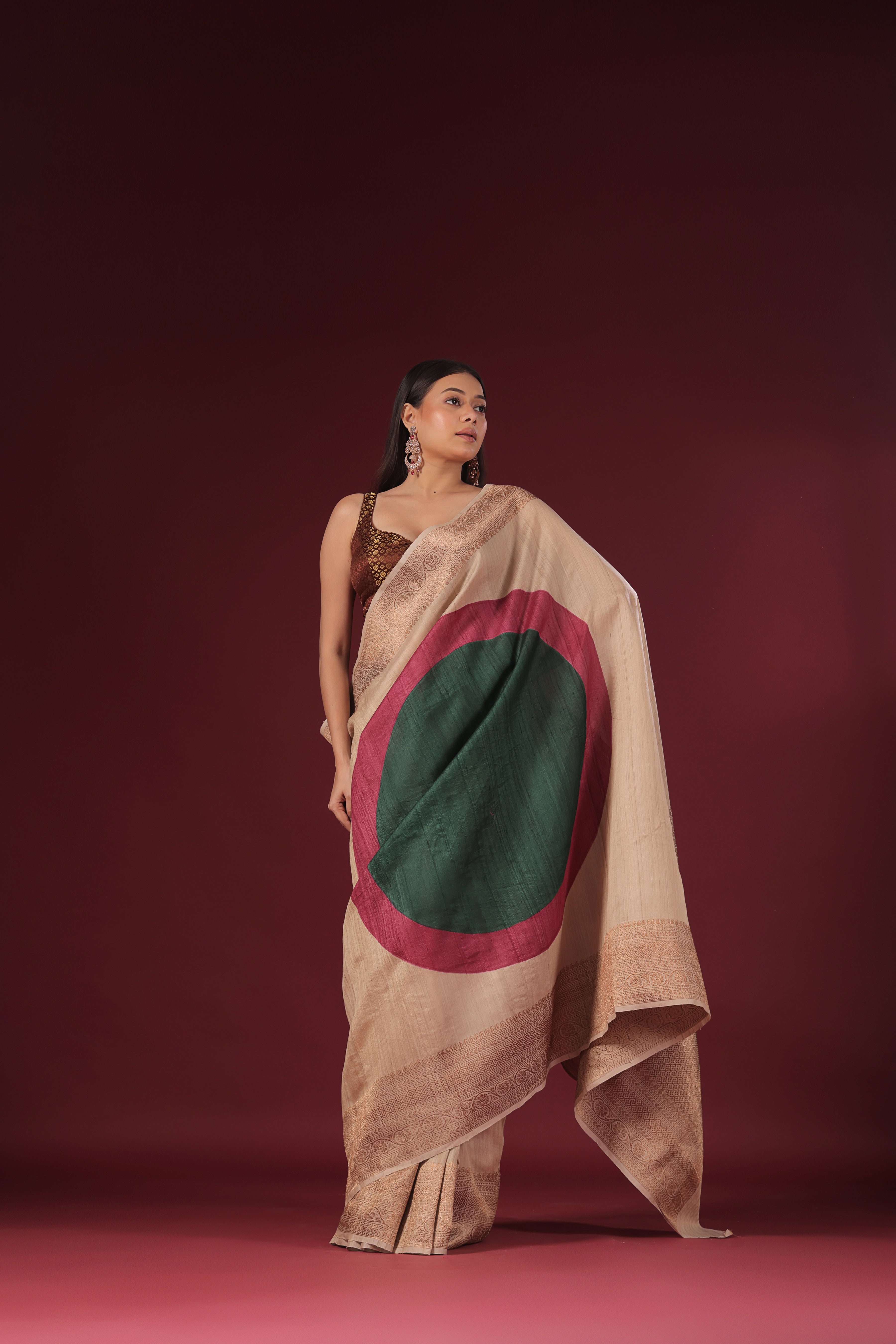Tussar Banarasi refers to a type of fabric that combines the traditional Banarasi weaving style with Tussar silk. Tussar silk, also known as Kosa silk, is a natural, wild silk produced by wild silkworms, primarily found in India. The fabric is highly valued for its unique texture, natural golden hue, and earthy feel, making it an excellent choice for luxurious textiles, particularly when combined with the rich heritage of Banarasi weaving.
Key Features of Tussar Banarasi Fabric:
-
Tussar Silk:
-
Natural Texture: Tussar silk is known for its slightly coarse, organic texture, which gives the fabric a more rustic and earthy appearance. Unlike mulberry silk, which is smooth and shiny, Tussar silk has a matte finish with a natural sheen.
-
Golden Hue: Tussar silk has a natural golden or beige tint that adds to its unique charm, which can range from light beige to deep golden tones. This gives the fabric a warm and rich look.
-
Breathability: Like all silks, Tussar is breathable, making it comfortable to wear in both warm and cool climates.
-
Banarasi Weaving:
-
Intricate Designs: Banarasi weaving is known for its complex and ornate patterns, typically involving floral motifs, paisleys, and geometric shapes. These patterns are often woven using zari, a metallic thread, which can be made of gold or silver to add richness to the fabric.
-
Handwoven Tradition: The Banarasi weaving technique is usually done by hand on traditional looms, which allows for the creation of highly detailed and intricate designs. This weaving process is labor-intensive, contributing to the fabric’s luxurious appeal.
-
Zari Work: Banarasi fabrics are often embellished with zari, which is used to create a shimmer effect with metallic threads. Zari work in Tussar Banarasi fabric can create beautiful borders, intricate patterns, or floral motifs that make the fabric stand out.
-
Appearance and Color:
- Tussar Banarasi fabrics come in a wide range of colors, from rich gold, red, and maroon to deep blues, greens, and purples. The natural color of Tussar silk enhances the richness of the dyes, making the fabric vibrant yet grounded.
- The shimmering zari thread contrasts beautifully against the matte finish of the Tussar silk, creating a unique visual texture that is both sophisticated and bold.
-
Versatility:
-
Sarees: One of the most popular uses for Tussar Banarasi fabric is in the creation of Banarasi sarees. These sarees, with their intricate designs and luxurious texture, are favored for weddings, festivals, and other ceremonial occasions.
-
Lehengas and Salwar Kameez: Tussar Banarasi fabric is also used to make lehengas, salwar kameez, and kurtas, which are often worn during traditional celebrations.
-
Dupattas and Shawls: The fabric is also commonly used for dupattas and shawls, which can be adorned with rich zari work to enhance the beauty of the garment.
-
Home Décor: Due to its opulent and textured nature, Tussar Banarasi fabric is sometimes used in home décor, such as cushion covers, curtains, and upholstery.
-
Durability:
- While Tussar silk is more durable than other types of silk due to its natural, coarser texture, it still requires delicate care. It is resistant to wear and tear, but it should be handled gently to preserve its sheen and quality.
Advantages of Tussar Banarasi:
-
Elegance and Richness: The combination of Tussar silk’s natural texture and the intricate Banarasi weaving creates a fabric that is both elegant and rich in appearance.
-
Unique Rustic Appeal: The matte finish of Tussar silk gives the fabric a distinct, earthy feel that sets it apart from polished silks. This makes it a preferred choice for those who appreciate a more natural, rustic aesthetic in their clothing.
-
Versatility for Occasions: Tussar Banarasi fabric is versatile enough to be used in a variety of garments for weddings, festivals, and special occasions, making it a go-to for traditional and formal attire.
-
Comfortable: Due to its breathability and natural fibers, Tussar Banarasi fabric is comfortable to wear in a range of climates.
Care and Maintenance:
-
Gentle Handling: Tussar Banarasi fabric is delicate, so it should be handled with care. It is best to dry clean it to maintain its texture and design.
-
Avoid Harsh Chemicals: To preserve the fabric's natural sheen and color, avoid using harsh detergents or chemicals. If washing by hand, use a mild detergent.
-
Storage: Store garments made from Tussar Banarasi fabric in a cool, dry place, away from direct sunlight, to prevent color fading. It is also advisable to wrap them in a cotton cloth to protect them from dust.
Conclusion:
Tussar Banarasi fabric is a luxurious and beautiful textile that combines the raw elegance of Tussar silk with the intricate artistry of Banarasi weaving. Its unique texture, golden hue, and rich designs make it a highly sought-after fabric for traditional garments like sarees and lehengas, as well as for elegant home décor. Whether worn on special occasions or used in high-end fashion, Tussar Banarasi fabric offers a timeless appeal.















